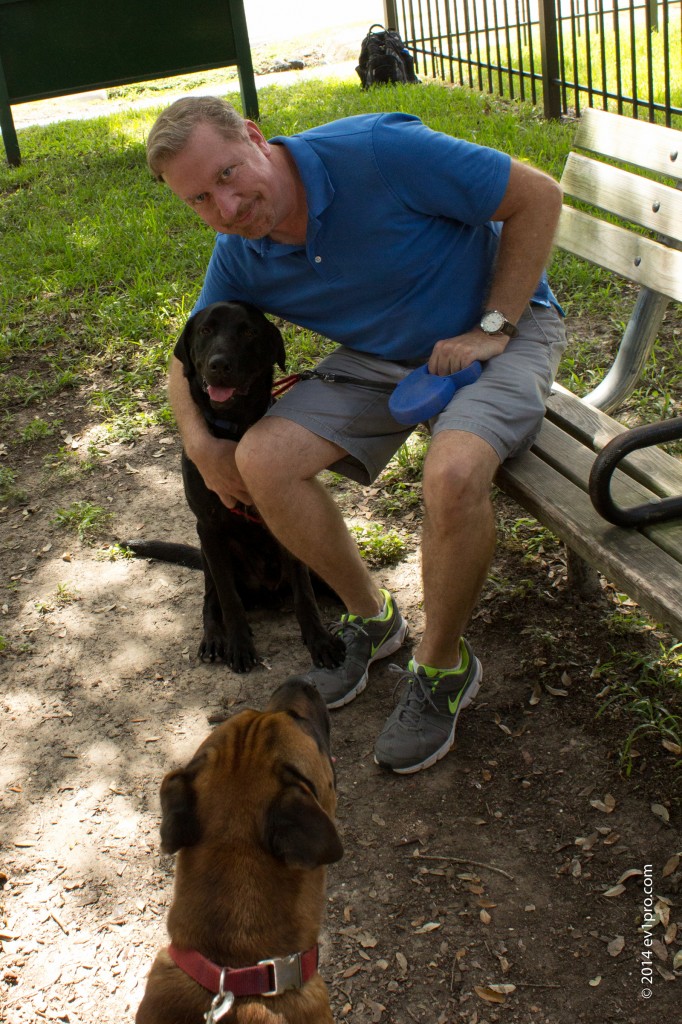Dogged Determination: Caring For Abandoned Canines Is Hard, But For One Montrose Man Not Caring Is Harder

The sixth time Mark Lankford went wooing, he brought a chicken. Lankford, a blond, boyishly good-looking tax auditor who lives in East Montrose, was smitten the first time he saw a little white terrier cowering in an alley in Channelview. But it took determination to save her. For five days, Lankford returned to the spot; the terrier wouldn’t come close. On the sixth day, armed with a rotisserie chicken, Lankford shredded meat into a trail to his car. The terrier snuffled her way through the door, and into a new life with Lankford.
That was in 2006. In the years since, the 52-year old Lankford has become something of a reluctant St. Francis. The little terrier, now named Rosie, was the first of some 20 dogs he would scoop up from Houston’s streets. Five of those Lankford adopted as his own. The rest he found new homes for with a resolve that can only be called dogged. It’s not been an easy task; while some of the dogs went into happy households quickly, others took more time, time in which he had to feed, fix, and have them vaccinated at his own expense. Right now, Lankford is trying to get two of his rescue dogs adopted together: a noble-natured Labrador retriever named Max and his best friend, a smudge-faced boxer mix called Big Boy.
“It wasn’t my intention to start rescuing dogs,” Lankford says, almost apologetically. “I just knew Rosie wouldn’t survive on the street.”
Lankford saves dogs by choice, of course. But because he is as pragmatic as he is kind, he frets about the responsibility he is taking on. “I don’t know what to do,” he complained recently while walking Max. “I can’t add another dog to the ones I have. I just can’t.” Watching him lovingly, Max clearly would like nothing better.

If at times Lankford feels he is alone in his effort to rescue pets others have abandoned, he is actually part of a breed. There are, of course, a multitude of animal welfare organizations, big and small, across the country. But they can only do so much, and in areas where they don’t always reach, from prosperous neighborhoods such as Montrose to hard-bitten projects and bleak country towns, there are individuals such as Lankford driven to do what they can, on their own, to save one animal at a time.
In the view of Best Friends Animal Society, a national leader in animal welfare, such individuals can have a surprising impact. “They are voices for these animals in their own neighborhoods. They are also role models,” says Holly Sizemore, Best Friends’ director of community programs and services.
“Many of these individuals do join together to make change,” Sizemore adds. “That’s how I came to this work. I worked as a waitress in Salt Lake City, and I’d see stray cats coming out of the woodwork on my way home from the night shift. This was 20 years ago. There was nothing in place for them. So I started to rescue them. Eventually, that work became a nonprofit.”
Lankford, for his part, remains something of a lone wolf. He supports Houston’s animal welfare groups, but works independently of them. The problem, he says, is that these groups are already drowning in abandoned pets. These include the slowly improving BARC, the city shelter, which in past years was known more for killing animals than helping them. There’s also Friends for Life, Houston’s no-kill shelter; Red Collar Rescue, a group whose founder handpicks its rescues; and Barrio Dogs, which focuses on education as well as finding fosters for street dogs. Then there’s No-Kill Houston, which lobbies against euthanasia as an animal control strategy, and SNAP, which tries to staunch Houston’s tidal wave of unwanted animals with low cost spaying and neutering.
The list could go on, but it’s not one Lankford has had much luck with, either because they can’t meet his expectations, or he theirs. “I don’t have the heart to take a dog to BARC,” he says. “It’ll be dead in days. The no-kill shelter makes you foster first for eight or nine months before they’ll take a dog from you. And Barrio Dogs doesn’t take dogs from individuals. I guess they feel that it’s been rescued, it is in safe hands.”
Lankford even drove a dog to Austin, where a few years ago the municipal shelter dedicated itself to becoming a no-kill facility. But something went wrong: the shelter euthanizes animals with behavioral problems, and Lankford got word, too late, that the dog he brought got stamped with that label.
The shelters, no doubt, have a slightly different take on things than Lankford does. Still, he believes, someone must help the stray dogs he sees in Houston’s parks and streets. It’s just that that someone, often, is Lankford himself. He insists he doesn’t go looking. But his dedication may have been destined.

Raised in Louisiana by parents who worked in the oil and accounting industries, Lankford grew up in a cacophony of pet dogs, cats, turtles, and birds. “We all loved animals,” he says. Healing was also a family tradition: Lankford’s stepfather, brother, sister, and brother-in-law are all physicians or psychologists. ”The first dog I rescued,” Lankford says, “was Keshi, a puppy at the Zuni Reservation in New Mexico, where my sister was working as a doctor. A nurse rescued the dog. I got a health certificate and a plane ticket and took it home to Louisiana.”
That was a one-time event until Lankford found himself in Houston. He had majored in architecture, but halfway through college, the economy sputtered and he switched to accounting, where he showed a gift for putting stray numbers in place. A job auditing oil companies lured him to Houston.
With plenty of room in his new Montrose house, Lankford could indulge his childhood passion for dogs. He just didn’t guess how many he would find here.
An estimated 1.2 million homeless cats and dogs roam Houston; local shelters kill 80,000 plus animals annually, some feral, some stray, and others pets abandoned by their owners. While pet owners dump animals in every part of town, including Montrose, certain quadrants are known for their discarded dogs and cats. Typically, the dumping grounds lie en route to low-income neighborhoods – places where people move often from small apartments; where crises thwart planning for the next meal, not to mention the care of a puppy; and where life can be so harsh for humans that disposing of an animal doesn’t seem much of a departure.
More than a dozen of Lankford’s rescues have come from one of these dumping grounds, Maxey Park, home to the second official dog park in the Houston Parks and Recreation system. A huge, wooded preserve where city dogs can ramble in bliss, it’s a place Lankford used to go weekly. But at night other dog owners come too, and shove their pets out of car doors to die. That’s how Lankford found Big Boy. “He didn’t need coaxing,” Lankford says. ”All the dogs I’ve found there are so eager for a home. They head right for my car.”
Sickened by what he’d seen at Maxey Park, Lankford emailed local candidates in recent elections to demand solutions. Harris County Commissioner Steve Radack was the only one who bothered to answer, inviting Lankford to visit. (Lankford hasn’t gone yet.) Lankford also wrote to Mayor Annise Parker, proposing measures such as a city park ranger, a video camera, and No Dumping signs.
“Since last Saturday,” Lankford wrote in August, “five dogs have been abandoned at the Maxey Road Dog Park. From February until now, that is at least 13 dogs I have personally found abandoned at the park … Other people have told me about countless other dogs that have been dumped. . . Another man and I took shifts last Saturday staying with puppies at the park until the SPCA showed up six hours later.”
Parker’s office, Lankford says, promptly fixed a gate in the park, but wrote back ruling out his other suggestions.
“My family has told me to stop going to Maxey Road,” Lankford says. He heaves a sigh. But here is the nature of a dog rescuer: He still sometimes goes.

Thus far, Lankford has found homes for his Maxey Road rescues with siblings, friends, and at least three neighbors within a few blocks. But like many such independent animal rescuers, he soon ran out of personal contacts who could take an animal in. So in gently desperate Facebook posts Lankford is expanding his outreach to neighbors he doesn’t yet know. And, because this is Montrose, he makes new friends constantly walking his dogs.
”That’s how I’ve met all my friends in this neighborhood,” Lankford says. ” I have a friend now who lived here for years, and didn’t know anyone until he got a dog.”
He is hoping one of these new acquaintances might be able to adopt Max and Big Boy, the Labrador and boxer pair who are his latest project. Big Boy is a particular concern. Lankford already found Big Boy a home once, but his new owner can no longer care for him, so Lankford has dedicated himself to finding the boxer another, more permanent place to live.
True to his name, Big Boy is large, but so graceful and affectionate that if Langford were to play favorites, Big Boy might win. Today, Big Boy is still at his current owner’s home, awaiting his future. Lankford has come to visit, and Big Boy seems to sense his old friend’s approach. Big Boy is hidden behind a metal wall, secluded as a novitiate. He doesn’t bark. But as Lankford walks down the sidewalk to say hello, a smudgy-black snout frantically noses from under the wall. It breathes deeply. It tries hard to get close. Lankford leans downward.
‘Hey, Big Boy,” he says. ”Don’t worry.”
